
PREMIER League, AUGUST 18 2025
Calafiori (13)
Arsenal got their latest tilt at the Premier League title off to a winning start with this opening-weekend win at Old Trafford. It was an all too familiar feeling for Manchester United, who lost nine times at home in the league last season. This time, however, it was a closely fought game that offered hope for the home side that they are moving in the right direction.
Arsenal’s winning goal came after just 13 minutes – fittingly from a set-piece, given their reputation for being clinical from dead-ball situations. United goalkeeper Altay Bayindir got a weak hand on a dangerous Declan Rice corner, from which Riccardo Calafiori was able to nod home. Patrick Dorgu hit the post for United, but despite featuring three of their new attacking signings and some generally positive play, they were unable to find an equaliser.
How the managers saw it
“We were more aggressive than last year,” said United head coach Ruben Amorim. “We sprint more. We were more brave. We let one against one all the game. We pressed high. And then with the ball, we have quality… the most important thing, we were not boring.”
“We did two things very well,” said Mikel Arteta of his Arsenal team. “One, to take the set-piece. And then [how we] react to, especially, mistakes. Some of them are necessary, some of them unusual. But the way every single player reacted to that gives us the opportunity to win the game.”
 123415138182710191426333684114711
12341513818271019142633368411471119/7
SHOTS / ON TARGET
9/3
62%
POSSESSION
38%
30
ATTACKS INTO AREA
21
1.6
EXPECTED GOALS (XG)
0.87
United’s versatile front line
Manchester United attacked with a 3-2-4-1 shape, but built directly from back to front. Their long passes into the front line disrupted Arsenal’s back four and gave them multiple final-third entries early on. On United’s right, Bryan Mbeumo and Diogo Dalot overlapped and underlapped around each other to attack against Calafiori, forcing Gabriel Martinelli to recover all the way back. On their left, Bruno Fernandes supported Mason Mount and Dorgu from central midfield, as well as providing forward runs from deep – especially when Matheus Cunha dropped short to receive (below). In fact, Cunha could have dropped more in the first half, to link and disrupt.

United regularly serviced their front line with long passes from the back and direct switches of play to their far wing-back. Their attacking combinations against Arsenal’s back line were particularly purposeful from the left, where Mount, Dorgu and Fernandes were closely connected. This trio were able to work attempts on goal and linked into Cunha, who supported by moving across (below). On their right, Mbeumo and Dalot continued to attack as a wide pair, but at times United lacked the penalty-box numbers to benefit from any subsequent crosses.

Arsenal’s wide advances
From Arsenal’s 4-3-3 shape with the ball, their centre-backs split to build around United’s front three. With Martín Zubimendi often marked, Rice and Martin Ødegaard made wide runs that helped Arsenal to build around, working in spaces between the advancing full-backs and wide centre-backs (below). When they were followed by their direct markers – Fernandes and Casemiro – big central spaces opened up. Arsenal then had access into their narrowing wingers, or straight into Viktor Gyökeres, who battled against Matthijs de Ligt throughout the first half.
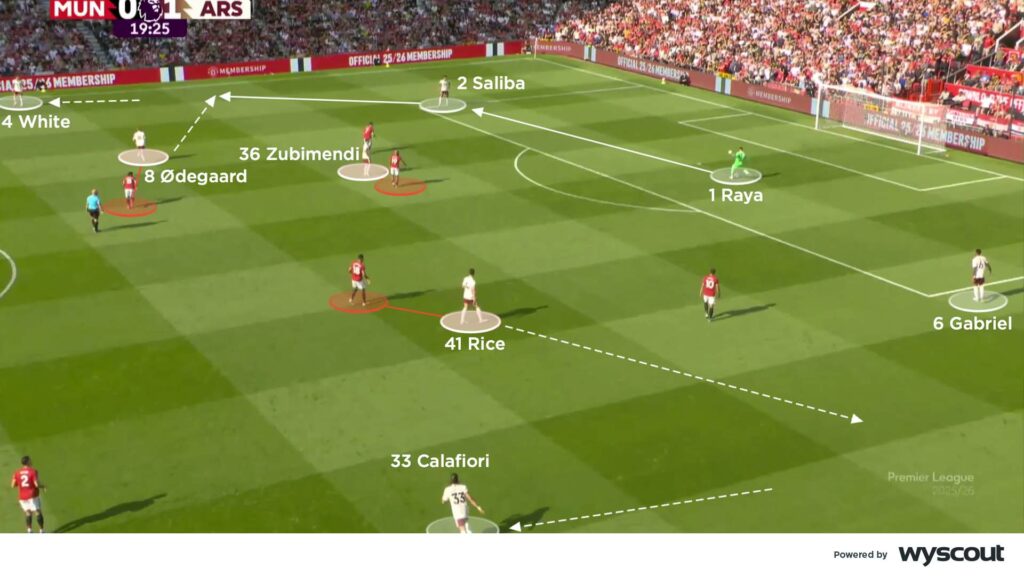
As Arsenal began to have more of the ball for longer sequences, they pinned United into a back five. From there, the visitors’ advanced midfielders no longer needed to move wide to receive. Instead they stayed central, with Ødegaard in particular growing in influence between the lines. Arsenal’s full-backs then progressed forward as the out ball from the back. When one full-back drove forward to combine with their winger ahead, the other narrowed, joining the attack from the far side, opposite to the central-midfielder closest to the ball (as with Calafiori in relation to Ødegaard, below).
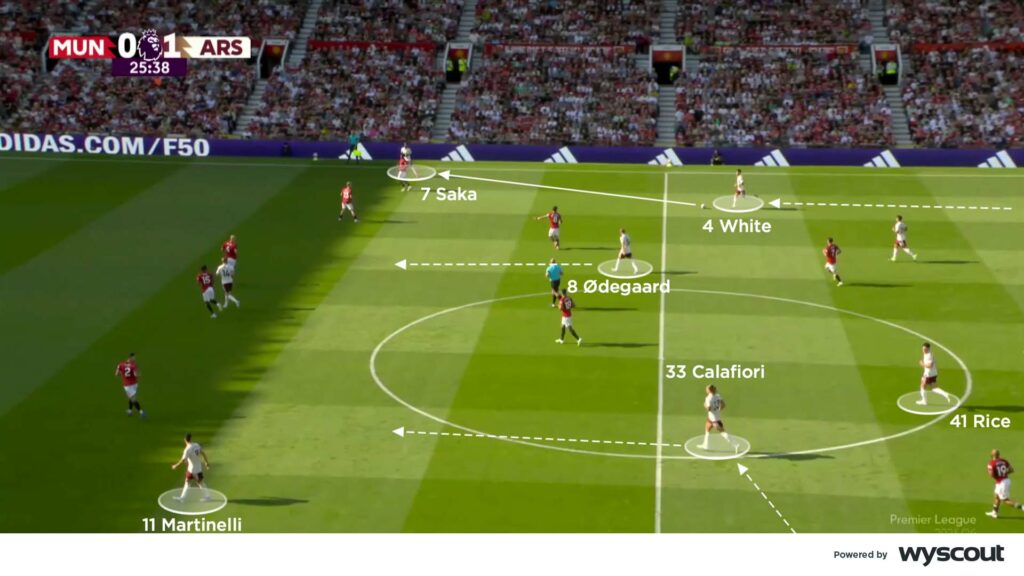
The major issue with this was that whenever United won possession in the middle third, huge wide spaces were available for counter-attacks due to Arsenal’s high full-backs. In conjunction with United’s direct passing, Arsenal thus looked vulnerable when they didn’t progress up the pitch with sequences of passes. Indeed, the visitors had two let-offs in the first half: when an Mbeumo shot was blocked after he caught out Calafiori’s advancing; then when Dorgu hit the post, exploiting Ben White being well ahead of play on a turnover of possession (below). As a result, the game entered a period of end-to-end counters and transitions, but neither side managed to capitalise.
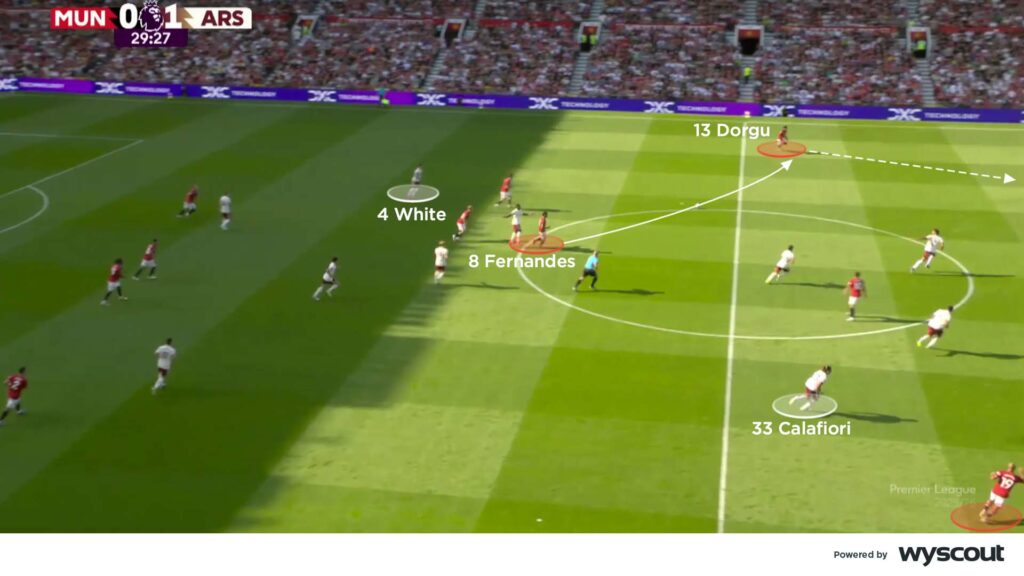
United’s diminishing attacking play
After Amorim made several second-half substitutions, United continued to attack using a narrow front three, supported by an additional wide presence. On for Dalot, Amad Diallo’s dribbling threat worked around Mbeumo, as this wide-pair attacked from United’s right. Diallo’s extra touches and often slower attacking play meant a decrease in United’s early crossing compared to the first half – even with Benjamin Šeško added to the front line (for Mount, on 65 minutes). On United’s left, Luke Shaw began to step in from the back three, with Fernandes much deeper in the build phase, while Cunha – now on the left – rotated with Dorgu (below). But United struggled to recreate their left-sided combinations from the first half. Arsenal, meanwhile, increasingly reduced the distance between their back line and midfield unit when defending.
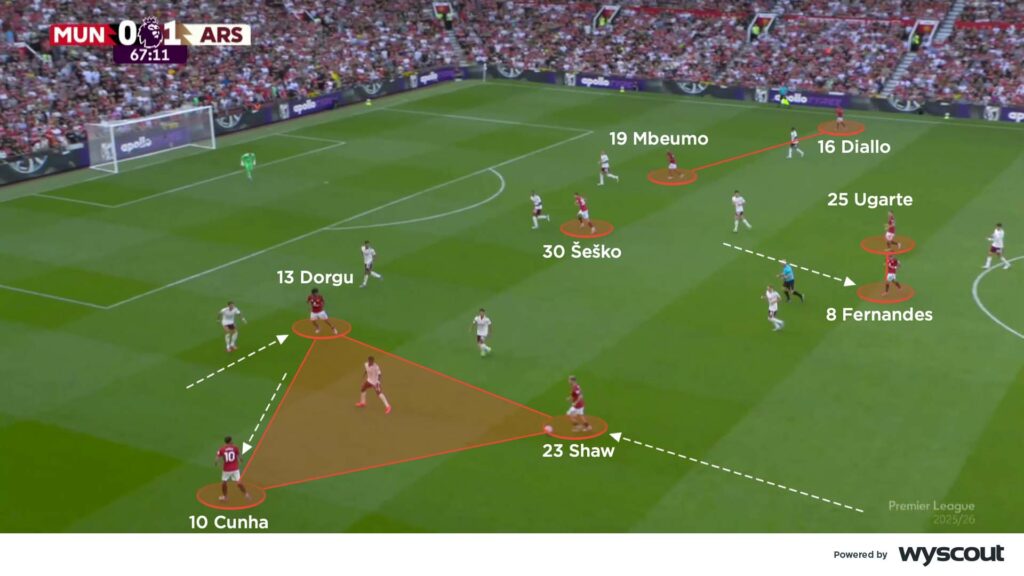
Whenever Arsenal dropped into their 4-4-2 low block, United struggled to break through, around or over. Despite United’s direct build-up and a lot of final-third entries, the compactness of Arsenal’s second-half shape made it easier to defend this direct play. Arsenal also limited the hosts’ combinations around the edge of the penalty area.
Arteta’s team were actually most vulnerable from their own poor counter-attacking. As they broke forward they failed to secure play inside United’s half for long enough to flip the momentum in the second period. The likes of Cunha and Mbeumo thrived on United’s attacking transitions, as their back line skipped the midfield and hit the front line (below).
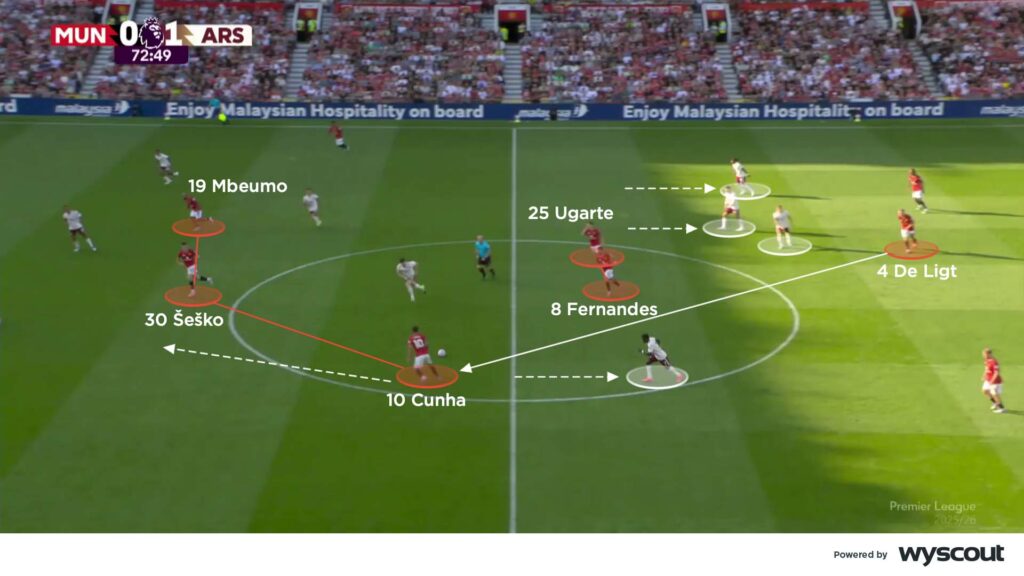
United had some promising final-third entries and threatening moments as a result. But Arsenal’s back line and central midfield in particular battled to keep a clean sheet, frustrating the home side. While neither team could be completely satisfied at the final whistle, for Arsenal the result was very welcome. United will hope their performance points to better days ahead.
To learn more from professional coaches at Coaches’ Voice, visit CV Academy



